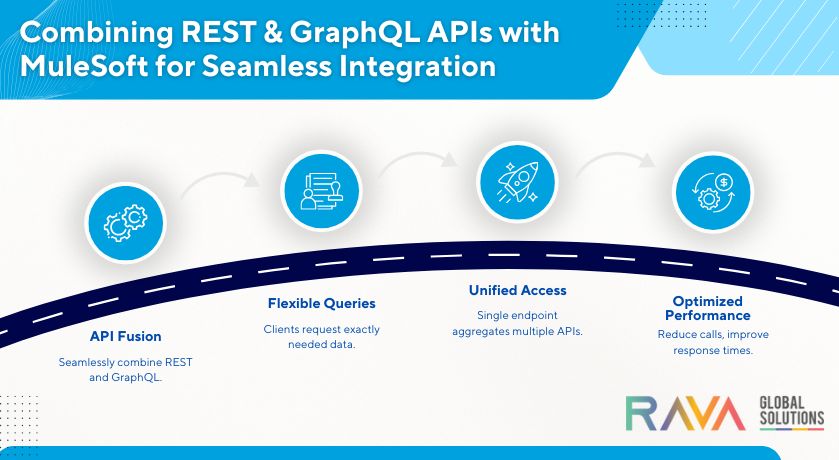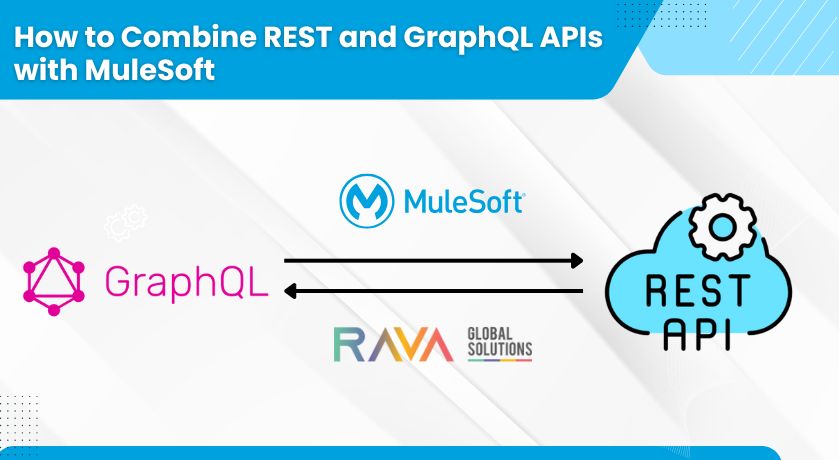In an increasingly connected world, businesses need faster, more flexible, and efficient ways to deliver data and services across applications. APIs remain the backbone of modern integration, but as API design evolves, so do the challenges in managing diverse API architectures. REST has long been the industry standard, yet GraphQL is rapidly gaining traction for its client-driven flexibility and precise data fetching capabilities.
At RAVA Global Solutions, recognized as the best MuleSoft partner USA and the best MuleSoft service provider USA, we understand how to leverage both REST and GraphQL APIs within the powerful MuleSoft Anypoint Platform to enable seamless integration and superior developer experiences.
MuleSoft offers a variety of powerful features that streamline data integration and API-led connectivity. To dive deeper into these capabilities, check out The 7 Key Features of MuleSoft You Should Know.
In this article, we explore when and how to combine REST and GraphQL using MuleSoft, unlocking the best of both worlds for your enterprise.
What Are REST and GraphQL APIs?
REST APIs
REST (Representational State Transfer) is an architectural style widely used for building scalable web services. It operates over HTTP, using standard methods like GET, POST, PUT, DELETE to perform operations on resources represented as URLs. REST APIs are simple, stateless, and cacheable, which makes them a staple in enterprise systems.
GraphQL APIs
GraphQL, developed by Facebook, is a query language and runtime for APIs that allows clients to request exactly the data they need. Unlike REST’s fixed endpoints, GraphQL exposes a single endpoint that clients can query flexibly, reducing over-fetching and under-fetching of data.
Why Combine REST and GraphQL APIs?
Both REST and GraphQL have unique strengths and limitations. Combining them can deliver a more robust integration strategy:
- Leverage Existing REST APIs: Most enterprises already have a vast landscape of REST APIs powering their backend systems.
- Flexible Data Queries: GraphQL enables clients to tailor data requests dynamically, reducing payload size and improving performance.
- Optimize Frontend Experience: GraphQL empowers frontend developers with more control and efficiency without requiring backend changes.
- Incremental Migration: Enterprises can adopt GraphQL on top of existing REST services without a complete overhaul.
- Unify Multiple APIs: GraphQL can aggregate data from multiple REST endpoints into a single, cohesive API response.
How MuleSoft Simplifies Combining REST and GraphQL
MuleSoft’s Anypoint Platform excels at API-led connectivity and hybrid integration, making it an ideal solution for orchestrating REST and GraphQL APIs together.
1. Use MuleSoft as a GraphQL Server or Proxy
MuleSoft can expose a GraphQL endpoint by acting as a proxy in front of your REST APIs. This allows you to:
- Define GraphQL schemas that map to underlying REST endpoints.
- Translate GraphQL queries into REST calls.
- Aggregate multiple REST responses into a unified GraphQL response.
- Enforce security, rate limiting, and monitoring centrally through Anypoint Platform.
2. Leverage MuleSoft’s API Gateway
With MuleSoft’s API Gateway, you can seamlessly manage both REST and GraphQL APIs by applying policies such as authentication, caching, throttling, and analytics uniformly across API types.
3. Design with Anypoint Studio
Anypoint Studio’s drag-and-drop interface lets developers visually design flows that handle GraphQL requests, transform data formats, and connect to various REST services without writing extensive code.

Practical Use Case: Building a Unified Customer Data API
Imagine a scenario where a company has multiple REST APIs for customer data: one for profile info, one for orders, another for support tickets. Instead of requiring frontend apps to call each REST API separately, MuleSoft can provide a unified GraphQL API:
- The GraphQL schema defines queries like customer(id) returning nested data from all REST services.
- When the client queries customer(id) { profile, orders, tickets }, MuleSoft internally makes REST calls, transforms responses, and assembles a single JSON payload.
- This results in fewer network requests and faster load times for the frontend.
Best Practices When Combining REST and GraphQL with MuleSoft
- Start Small: Begin by exposing key REST endpoints as GraphQL fields to gradually introduce GraphQL.
- Schema Management: Maintain clear and up-to-date GraphQL schemas aligned with underlying REST services.
- Optimize Performance: Use caching and batching techniques to minimize REST calls and improve response times.
- Centralize Security: Leverage MuleSoft’s robust security policies to protect both REST and GraphQL endpoints.
- Monitor and Analyze: Use Anypoint Monitoring to gain insights on usage patterns and performance.
One key advantage of MuleSoft is its robust API policies that enhance security, scalability, and maintainability across integrations. Learn more about how these policies work in How Can MuleSoft API Policies Improve Security, Scalability, and Maintainability in API Integrations?.
Why Choose RAVA Global Solutions for MuleSoft Integration?
As the best MuleSoft partner USA and the best MuleSoft service provider USA, RAVA Global Solutions offers unmatched expertise in API strategy and MuleSoft implementations. We empower businesses to:
- Seamlessly combine REST and GraphQL APIs to maximize flexibility.
- Accelerate digital transformation with scalable, secure API-led connectivity.
- Optimize developer productivity with modern integration patterns.
- Ensure smooth project delivery with expert MuleSoft consultants and certified architects.
Our proven track record in complex MuleSoft projects across industries makes us the trusted partner to navigate your API integration journey.
Conclusion
GraphQL’s rise doesn’t mean REST is obsolete. Instead, integrating both with MuleSoft creates a powerful, hybrid API ecosystem that adapts to diverse business needs. MuleSoft’s comprehensive platform enables enterprises to unlock the agility of GraphQL without abandoning their valuable REST investments.
If you’re ready to innovate your API strategy and combine the best of REST and GraphQL, contact RAVA Global Solutions — the best MuleSoft partner USA — today. Let us help you design flexible, scalable, and future-proof integration solutions that drive your business forward.
Reach out to RAVA Global Solutions now to learn more about our MuleSoft services and how we can elevate your API landscape!









